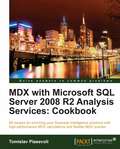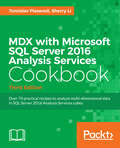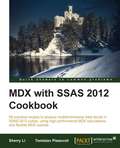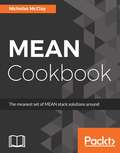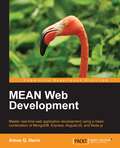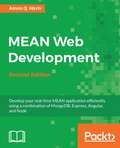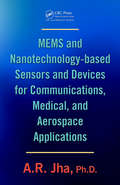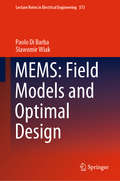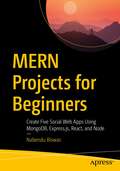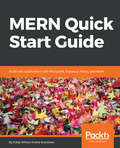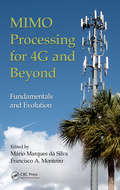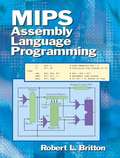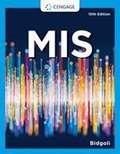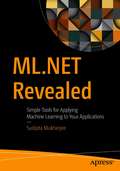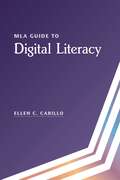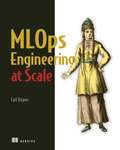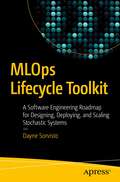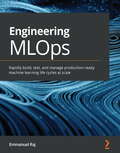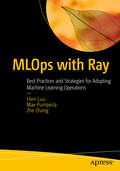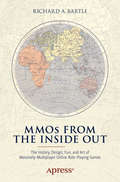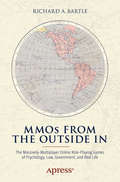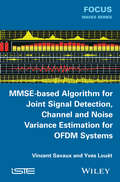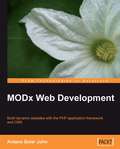- Table View
- List View
MDX with Microsoft SQL Server 2008 R2 Analysis Services Cookbook
by Tomislav PiasevoliThis book offers practical, task-based, and immediately usable recipes covering a wide range of MDX calculations and queries. In addition to its cookbook style, which ensures the solutions are presented in a clear step-by-step manner, the explanations are done in great detail, which makes it good learning material for everyone who has experience in MDX and wants to improve. The book is designed in such a way that you can read it chapter by chapter or refer to recipes in no particular order. However, some of the recipes depend on each another. When this is the case, you will be notified. The book is focused on Microsoft SQL Server 2008 R2 Analysis Services, but most of the concepts and explanation are also applicable to previous versions of Microsoft SQL Server Analysis Services. If you are a Microsoft SQL Server Analysis Services developer and want to improve your solutions using MDX, then this book is for you. The book assumes you have a working knowledge of MDX and a basic understanding of dimensional modeling and cube design.
MDX with Microsoft SQL Server 2016 Analysis Services Cookbook - Third Edition
by Tomislav Piasevoli Sherry LiOver 70 practical recipes to analyze multi-dimensional data in SQL Server 2016 Analysis Services cubes About This Book * Updated for SQL Server 2016, this book helps you take advantage of the new MDX commands and the new features introduced in SSAS * Perform time-related, context-aware, and business related-calculations with ease to enrich your Business Intelligence solutions * Collection of techniques to write flexible and high performing MDX queries in SSAS with carefully structured examples Who This Book Is For This book is for anyone who has been involved in working with multidimensional data. If you are a multidimensional cube developer, a multidimensional database administrator, or a report developer who writes MDX queries to access multidimensional cube, this book will help you. If you are a power cube user or an experienced business analyst, you will also find this book invaluable in your data analysis. This book is for you are interested in doing more data analysis so that the management can make timely and accurate business decisions. What You Will Learn * Grasp the fundamental MDX concepts, features, and techniques * Work with sets * Work with Time dimension and create time-aware calculations * Make analytical reports compact, concise, and efficient * Navigate cubes * Master MDX for reporting with Reporting Services (new) * Perform business analytics * Design efficient cubes and efficient MDX queries * Create metadata-driven calculations (new) * Capture MDX queries and many other techniques In Detail If you're often faced with MDX challenges, this is a book for you. It will teach you how to solve various real-world business requirements using MDX queries and calculations. Examples in the book introduce an idea or a problem and then guide you through the process of implementing the solution in a step-by-step manner, inform you about the best practices and offer a deep knowledge in terms of how the solution works. Recipes are organized by chapters, each covering a single topic. They start slowly and logically progress to more advanced techniques. In case of complexity, things are broken down. Instead of one, there are series of recipes built one on top of another. This way you are able to see intermediate results and debug potential errors faster. Finally, the cookbook format is here to help you quickly identify the topic of interest and in it a wide range of practical solutions, that is - MDX recipes for your success. Style and approach This book is written in a cookbook format, where you can browse through and look for solutions to a particular problem in one place. Each recipe is short, to the point and grouped by relevancy. All the recipes are sequenced in a logical progression; you will be able to build up your understanding of the topic incrementally.
MDX with SSAS 2012 Cookbook
by Tomislav Piasevoli Sherry LiThis book is written in a recipe-based style packed full of practical tips and techniques to help you analyse multidimensional data stored in SSAS 2012 cubes. If you need to master MDX queries in SSAS, then this book is for you!If you are a Microsoft SQL Server Analysis Services developer and want to improve your solutions using MDX, then this book is for you. This book is also an essential resource for report developers who need to access the multidimensional cubes through the MDX language. The book assumes you have some basic working knowledge of MDX and a basic understanding of dimensional modelling and cube design.
MEAN Cookbook
by Nicholas McclayOver 50 recipes to create full-stack high-performance web applications using pure JavaScript and the MEAN stack. About This Book • Architect a fully functional stand-alone web application, including the web server, database, and front-end web application • Improve the performance and maintainability of your MEAN stack application with tips for configuration and optimization • Highlights MEAN Stack best practices when working with your application Who This Book Is For If you are a JavaScript developer who wants to create high-performing, modern web applications with the MEAN stack, this is the book for you. Web developers familiar with some parts of the MEAN stack will find this a comprehensive guide to fleshing out the other technologies and skills they need to build all JavaScript web applications. Developers interested in transitioning from other web application stacks to an all-JavaScript environment will find a wealth of information about how to work in a MEAN stack environment. To get the most from this book, you should have a general understanding of web servers and web applications. You are expected to have a basic understanding of running JavaScript, both in a web browser and outside it, using Node.js and the NPM package manager. What You Will Learn • Bootstrap a new MEAN stack web application using Node.js and Express • Build a single-page application (SPA) with Angular and Angular-CLI • Improve browser performance by optimizing your web application resources using Webpack • Model complex JSON object relationships in MongoDB using Mongoose • Debug all the layers of a MEAN stack application, including working with source maps • Build Restful APIs using Express.js and JSON Web Token (JWT) for user authentication • Use automated testing to improve the reliability and quality of your MEAN stack application In Detail The MEAN Stack is a framework for web application development using JavaScript-based technologies; MongoDB, Express, Angular, and Node.js. If you want to expand your understanding of using JavaScript to produce a fully functional standalone web application, including the web server, user interface, and database, then this book can help guide you through that transition. This book begins by configuring the frontend of the MEAN stack web application using the Angular JavaScript framework. We then implement common user interface enhancements before moving on to configuring the server layer of our MEAN stack web application using Express for our backend APIs. You will learn to configure the database layer of your MEAN stack web application using MongoDB and the Mongoose framework, including modeling relationships between documents. You will explore advanced topics such as optimizing your web application using WebPack as well as the use of automated testing with the Mocha and Chai frameworks. By the end of the book, you should have acquired a level of proficiency that allows you to confidently build a full production-ready and scalable MEAN stack application. Style and Approach This book is a guide of MEAN Stack specific solutions to common web application problems and includes in-depth guides for each layer of the application stack. Readers looking to upgrade their MEAN Stack web application will find recipes within to help them transition.
MEAN Web Development
by Amos Q. HavivIf you are a web or a full-stack JavaScript developer who is interested in learning how to build modern web applications using the MEAN stack, this book is for you.
MEAN Web Development - Second Edition
by Amos Q. HavivDevelop your real-time MEAN application efficiently using a combination of MongoDB, Express, Angular, and Node About This Book * Construct a fully-functional MEAN application by using its components along with the best third-party modules * Harness the power of the JavaScript ecosystem to effectively run, build, and test your MEAN application * Gain a deep, practical understanding of real-time web application development through real-world examples Who This Book Is For If you are a JavaScript developer who is interested in building modern web applications using MongoDB, Express, Angular 2, and Node 5.0, then this book is for you. You only need knowledge of JavaScript development. What You Will Learn * Use MongoDB to store and retrieve your application's data * Connect your Express application to MongoDB and use the Mongoose module * Manage your users' authentication and offer them diverse login options using Passport * Structure and use an Angular 2 application in your MEAN project * Use Socket.io to create real-time communication between your client and server * Test your application's Express and Angular 2 entities In Detail The MEAN stack is a collection of the most popular modern tools for web development that helps you build fast, robust, and maintainable web applications. Starting with the MEAN core frameworks, this pragmatic guide will explain the key concepts of each framework, how to set them up properly, and how to use popular modules to connect it all together. By following the real-world examples shown in this tutorial, you will scaffold your MEAN application architecture, add an authentication layer, and develop an MVC structure to support your project development. You will learn the best practices of maintaining clear and simple code and will see how to avoid common pitfalls. Finally, you will walk through the different tools and frameworks that will help expedite your daily development cycles. Watch how your application development grows by learning from the only guide that is solely orientated towards building a full, end-to-end, real-time application using the MEAN stack! Style and approach This comprehensive guide covers every part of the MEAN stack, and focuses on the gestalt power of the apps they can create through practical, real-world examples
MEMS and Nanotechnology-Based Sensors and Devices for Communications, Medical and Aerospace Applications
by A. R. JhaThe integration of microelectromechanical systems (MEMS) and nanotechnology (NT) in sensors and devices significantly reduces their weight, size, power consumption, and production costs. These sensors and devices can then play greater roles in defense operations, wireless communication, the diagnosis and treatment of disease, and many more applicat
MEMS: Field Models and Optimal Design (Lecture Notes in Electrical Engineering #573)
by Paolo Di Barba Slawomir WiakThis book highlights numerical models as powerful tools for the optimal design of Micro-Electro-Mechanical Systems (MEMS). Most MEMS experts have a background in electronics, where circuit models or behavioral models (i.e. lumped-parameter models) of devices are preferred to field models. This is certainly convenient in terms of preliminary design, e.g. in the prototyping stage. However, design optimization should also take into account fine-sizing effects on device behavior and therefore be based on distributed-parameter models, such as finite-element models. The book shows how the combination of automated optimal design and field-based models can produce powerful design toolboxes for MEMS. It especially focuses on illustrating theoretical concepts with practical examples, fostering comprehension through a problem-solving approach. By comparing the results obtained using different methods, readers will learn to identify their respective strengths and weaknesses. In addition, special emphasis is given to evolutionary computing and nature-inspired optimization strategies, the effectiveness of which has already been amply demonstrated. Given its scope, the book provides PhD students, researchers and professionals in the area of computer-aided analysis with a comprehensive, yet concise and practice-oriented guide to MEMS design and optimization. To benefit most from the book, readers should have a basic grasp of electromagnetism, vector analysis and numerical methods.
MERN Projects for Beginners: Create Five Social Web Apps Using MongoDB, Express.js, React, and Node
by Nabendu BiswasLearn how to use the MERN stack (MongoDB, Express.js, React, and Node) to build five fully functioning web apps for dating, video sharing, messaging, and social media. While creating these web apps, you’ll learn key development concepts including how to use React hooks, Redux, MongoDB, Express, Heroku, Firebase, Material UI, and Google authentication. By expanding your portfolio with the projects you create, you will be well equipped as front-end developer. You will first create a dating site with a swiping feature and chat functionality. You will then build a video sharing app with videos displaying vertically. Next, you will learn to build an awesome messaging web app. Users will be able to chat in real time, as well as log in to their account using Google authentication. You will also create a photo sharing app and social media web apps with the ability to post images with captions and log in using email and password authentication. Most MERN tutorials out there today cover basic web apps but it is capable of so much more – learn how to use this stack to its full potential and build projects that can be converted into full scaled start-ups with additional features. What You'll LearnWork with React hooks and React routerExamine powerful MongoDB services for easy to use and setupCreate routes using Node and host on HerokuStudy different authentication techniquesDeploy all sites using simple Firebase hostingUse the powerful React ecosystem to add functionalities to your apps Who This book Is For Those who have just started their career in web development and have basic knowledge of the core web technologies: HTML, CSS, and JavaScript. Those with basic React development and feel ready to explore its capabilities further.
MERN Quick Start Guide: Build web applications with MongoDB, Express.js, React, and Node
by Eddy WilsonBuild web applications with MongoDB, ExpressJS, React, and NodeKey FeaturesBuild applications with the MERN stackWork with each component of the MERN stackBecome confident with MERN and ready for more!Book DescriptionThe MERN stack is a collection of great tools—MongoDB, Express.js, React, and Node—that provide a strong base for a developer to build easily maintainable web applications. With each of them a JavaScript or JavaScript-based technology, having a shared programming language means it takes less time to develop web applications. This book focuses on providing key tasks that can help you get started, learn, understand, and build full-stack web applications. It walks you through the process of installing all the requirements and project setup to build client-side React web applications, managing synchronous and asynchronous data flows with Redux, and building real-time web applications with Socket.IO, RESTful APIs, and other concepts. This book gives you practical and clear hands-on experience so you can begin building a full-stack MERN web application.Quick Start Guides are focused, shorter titles that provide a faster paced introduction to a technology. They are for people who don't need all the detail at this point in their learning curve. The presentation has been streamlined to concentrate on the things you really need to know.What you will learnGet started with the MERN stackInstall Node.js and configure MongoDBBuild RESTful APIs with Express.js and MongooseBuild real-time applications with Socket.IO Manage synchronous and asynchronous data flows with ReduxBuild web applications with React Who this book is forThe book is for JavaScript developers who want to get stated with the MERN Stack.
MIMO Processing for 4G and Beyond: Fundamentals and Evolution
by Mário Marques da Silva Francisco A. MonteiroMIMO Processing for 4G and Beyond: Fundamentals and Evolution offers a cutting-edge look at multiple-input multiple-output (MIMO) signal processing, namely its detection (in both time and frequency domains) and precoding. It examines its integration with OFDM, UWB, and CDMA, along with the impact of these combinations at the system level. Massive M
MIPS Assembly Language Programming
by Robert BrittonUsers of this book will gain an understanding of the fundamental concepts of contemporary computer architecture, starting with a Reduced Instruction Set Computer (RISC).
MIS
by Hossein BidgoliLearn the principles of MIS as you explore the latest developments and industry trends with MIS 10. This practically focused approach helps you master foundational MIS concepts that will guide your career. You examine the latest topics, such as cloud computing, AR/VR, quantum computing and blockchain, with the most current MIS title on the market. Have you ever wondered what you would have done as a company leader in a critical moment? With this edition's MindTap digital experience, you can strengthen your decision-making skills with "YouDecide" -- new interactive case studies that bridge technology and business strategy and position you as the decision maker.
ML for the Working Programmer
by Lawrence C. PaulsonThe new edition of this successful and established textbook retains its two original intentions of explaining how to program in the ML language, and teaching the fundamentals of functional programming. The major change is the early and prominent coverage of modules, which the author extensively uses throughout. In addition, Paulson has totally rewritten the first chapter to make the book more accessible to students who have no experience of programming languages. The author describes the main features of new Standard Library for the revised version of ML, and gives many new examples, e.g. polynomial arithmetic and new ways of treating priority queues. Finally he has completely updated the references. Dr. Paulson has extensive practical experience of ML, and has stressed its use as a tool for software engineering; the book contains many useful pieces of code, which are freely available (via Internet) from the author. He shows how to use lists, trees, higher-order functions and infinite data structures. He includes many illustrative and practical examples, covering sorting, matrix operations, and polynomial arithmetic. He describes efficient functional implementations of arrays, queues, and priority queues. Larger examples include a general top-down parser, a lambda-calculus reducer and a theorem prover. A chapter is devoted to formal reasoning about functional programs. The combination of careful explanation and practical advice will ensure that this textbook continues to be the preferred text for many courses on ML for students at all levels.
ML.NET Revealed: Simple Tools for Applying Machine Learning to Your Applications
by Sudipta MukherjeeGet introduced to ML.NET, a new open source, cross-platform machine learning framework from Microsoft that is intended to democratize machine learning and enable as many developers as possible.Dive in to learn how ML.NET is designed to encapsulate complex algorithms, making it easy to consume them in many application settings without having to think about the internal details. You will learn about the features that do the necessary “plumbing” that is required in a variety of machine learning problems, freeing up your time to focus on your applications. You will understand that while the infrastructure pieces may at first appear to be disconnected and haphazard, they are not. Developers who are curious about trying machine learning, yet are shying away from it due to its perceived complexity, will benefit from this book. This introductory guide will help you make sense of it all and inspire you to try out scenarios and code samples that can be used in many real-world situations.What You Will LearnCreate a machine learning model using only the C# languageBuild confidence in your understanding of machine learning algorithms Painlessly implement algorithms Begin using the ML.NET library softwareRecognize the many opportunities to utilize ML.NET to your advantageApply and reuse code samples from the bookUtilize the bonus algorithm selection quick references available onlineWho This Book Is ForDevelopers who want to learn how to use and apply machine learning to enrich their applications
MLA Guide to Digital Literacy
by Ellen C. CarilloStudents face challenges assessing, responding to, and producing information in today's fast-paced, complex digital landscape. This guide helps students understand why digital literacy is a critically important skill: their education, future careers, and participation in democratic processes rely on it. Hands-on, structured activities give students strategies for evaluating the credibility of sources, detecting fake news, understanding bias, and more. Readings and writing prompts support specific concepts, including how to craft a research question and effectively conduct searches. An appendix contains three sample lesson plans.
MLOps Engineering at Scale
by Carl OsipovDodge costly and time-consuming infrastructure tasks, and rapidly bring your machine learning models to production with MLOps and pre-built serverless tools!In MLOps Engineering at Scale you will learn: Extracting, transforming, and loading datasets Querying datasets with SQL Understanding automatic differentiation in PyTorch Deploying model training pipelines as a service endpoint Monitoring and managing your pipeline&’s life cycle Measuring performance improvements MLOps Engineering at Scale shows you how to put machine learning into production efficiently by using pre-built services from AWS and other cloud vendors. You&’ll learn how to rapidly create flexible and scalable machine learning systems without laboring over time-consuming operational tasks or taking on the costly overhead of physical hardware. Following a real-world use case for calculating taxi fares, you will engineer an MLOps pipeline for a PyTorch model using AWS server-less capabilities. About the technology A production-ready machine learning system includes efficient data pipelines, integrated monitoring, and means to scale up and down based on demand. Using cloud-based services to implement ML infrastructure reduces development time and lowers hosting costs. Serverless MLOps eliminates the need to build and maintain custom infrastructure, so you can concentrate on your data, models, and algorithms. About the book MLOps Engineering at Scale teaches you how to implement efficient machine learning systems using pre-built services from AWS and other cloud vendors. This easy-to-follow book guides you step-by-step as you set up your serverless ML infrastructure, even if you&’ve never used a cloud platform before. You&’ll also explore tools like PyTorch Lightning, Optuna, and MLFlow that make it easy to build pipelines and scale your deep learning models in production. What's inside Reduce or eliminate ML infrastructure management Learn state-of-the-art MLOps tools like PyTorch Lightning and MLFlow Deploy training pipelines as a service endpoint Monitor and manage your pipeline&’s life cycle Measure performance improvements About the reader Readers need to know Python, SQL, and the basics of machine learning. No cloud experience required. About the author Carl Osipov implemented his first neural net in 2000 and has worked on deep learning and machine learning at Google and IBM. Table of Contents PART 1 - MASTERING THE DATA SET 1 Introduction to serverless machine learning 2 Getting started with the data set 3 Exploring and preparing the data set 4 More exploratory data analysis and data preparation PART 2 - PYTORCH FOR SERVERLESS MACHINE LEARNING 5 Introducing PyTorch: Tensor basics 6 Core PyTorch: Autograd, optimizers, and utilities 7 Serverless machine learning at scale 8 Scaling out with distributed training PART 3 - SERVERLESS MACHINE LEARNING PIPELINE 9 Feature selection 10 Adopting PyTorch Lightning 11 Hyperparameter optimization 12 Machine learning pipeline
MLOps Lifecycle Toolkit: A Software Engineering Roadmap for Designing, Deploying, and Scaling Stochastic Systems
by Dayne SorvistoThis book is aimed at practitioners of data science, with consideration for bespoke problems, standards, and tech stacks between industries. It will guide you through the fundamentals of technical decision making, including planning, building, optimizing, packaging, and deploying end-to-end, reliable, and robust stochastic workflows using the language of data science. MLOps Lifecycle Toolkit walks you through the principles of software engineering, assuming no prior experience. It addresses the perennial “why” of MLOps early, along with insight into the unique challenges of engineering stochastic systems. Next, you’ll discover resources to learn software craftsmanship, data-driven testing frameworks, and computer science. Additionally, you will see how to transition from Jupyter notebooks to code editors, and leverage infrastructure and cloud services to take control of the entire machine learning lifecycle. You’ll gain insight into the technical and architectural decisions you’re likely to encounter, as well as best practices for deploying accurate, extensible, scalable, and reliable models. Through hands-on labs, you will build your own MLOps “toolkit” that you can use to accelerate your own projects. In later chapters, author Dayne Sorvisto takes a thoughtful, bottom-up approach to machine learning engineering by considering the hard problems unique to industries such as high finance, energy, healthcare, and tech as case studies, along with the ethical and technical constraints that shape decision making. After reading this book, whether you are a data scientist, product manager, or industry decision maker, you will be equipped to deploy models to production, understand the nuances of MLOps in the domain language of your industry, and have the resources for continuous delivery and learning. What You Will Learn Understand the principles of software engineering and MLOpsDesign an end-to-end machine learning systemBalance technical decisions and architectural trade-offsGain insight into the fundamental problems unique to each industry and how to solve them Who This Book Is For Data scientists, machine learning engineers, and software professionals.
MLOps using Azure Machine Learning: Rapidly build, test, and manage production-ready machine learning life cycles at scale
by Emmanuel RajThis book is for data scientists, software engineers, DevOps engineers, and machine learning developers who want to build, deploy, and maintain ML systems in production efficiently using MLOps principles and techniques. Basic knowledge of machine learning is required.
MLOps with Ray: Best Practices and Strategies for Adopting Machine Learning Operations
by Max Pumperla Zhe Zhang Hien LuuUnderstand how to use MLOps as an engineering discipline to help with the challenges of bringing machine learning models to production quickly and consistently. This book will help companies worldwide to adopt and incorporate machine learning into their processes and products to improve their competitiveness. The book delves into this engineering discipline's aspects and components and explores best practices and case studies. Adopting MLOps requires a sound strategy, which the book's early chapters cover in detail. The book also discusses the infrastructure and best practices of Feature Engineering, Model Training, Model Serving, and Machine Learning Observability. Ray, the open source project that provides a unified framework and libraries to scale machine learning workload and the Python application, is introduced, and you will see how it fits into the MLOps technical stack. This book is intended for machine learning practitioners, such as machine learning engineers, and data scientists, who wish to help their company by adopting, building maps, and practicing MLOps. What You'll Learn Gain an understanding of the MLOps discipline Know the MLOps technical stack and its components Get familiar with the MLOps adoption strategy Understand feature engineering Who This Book Is For Machine learning practitioners, data scientists, and software engineers who are focusing on building machine learning systems and infrastructure to bring ML models to production
MMOs from the Inside Out
by Richard A. BartleThis is an astonishing collection of ideas, information, and instruction from one of the true pioneers of Massively-Multiplayer Online Role-Playing Games. MMOs from the Inside Out: The History, Design, Fun, and Art of Massively-Multiplayer Role-playing Games speaks to the designers and players of MMOs, taking it as axiomatic that such games are inspirational and boundless forces for good. The aim of this book is to enthuse an up-coming generation of designers, to inspire and educate players and designers-to-be, and to reinvigorate those already working in the field who might be wondering if it's still all worthwhile. Playing MMOs is about fun, immersion, and identity. Creating MMOs is about imagination, expression, and art. MMOs are so packed with potential that today's examples are little more than small, pioneering colonies on the shore of a vast, uncharted continent. What wonders wait beyond the horizon? What treasures will explorers bring back to amaze us? MMOs from the Inside Out is for people with a spark of creativity: it pours gasoline on that spark. It: Explains what MMOs are, what they once were, and what they could - and should - become. Delves into why players play, and why designers design. Encourages, enthuses, enrages, engages, enlightens, envisions, and enchants. Doesn't tell you what to think, it tells you to think. What you'll learn You'll learn: Myriad ways to improve MMOs - and to decide for yourself whether these are improvements. What MMOs are; who plays them, and why. How MMOs became what they are, and what this means for what they will become. That you have it in you to make MMOs yourself. Who this book is for MMOs from the Inside Out is a book for those who wish to know more about game design in general and MMO design in particular. It's for people who play MMOs, for people who design MMOs, and for people who study MMOs. It's for people with a yearning to see beyond the world around them and to make manifest the worlds of their imagination. Table of Contents Part 1: How Game Developers See MMOs 1. MMO Design Insights 2. MMO Development: Systems and Security 3. MMO Operation: Community and Customer Service 4. Fun, Flow, Immersion, and Presence 5. The Past, Present, and Future of MMOs 6. Understanding MMOs Through Game Studies 7. Player Identity: Who Plays MMOs, Why they Play Them, and How They Play Them 8. The Constraints of Current MMO Production 9. Making a Difference by Reading This Book Part 2: How the World Sees MMOs 10. Understanding the Language of MMOs 11. Society's Demands: A Virtual World's Place in the Real World 12. Society's Concerns: How Non-Gamers See MMO Players 13. The Business of MMOs: How Developers and Players Make Money 14. Government and Law: The Real Legal Issues Around MMOs 15. Morality: Religion and Ethics in MMOs
MMOs from the Outside In
by Richard A. BartleThis follow-up volume to MMOs from the Inside Out is a further collection of bold ideas, information, and instruction from one of the true pioneers of Massively-Multiplayer Online Role-Playing Games. Whereas its predecessor looked at how MMOs can change the world, MMOs from the Outside In: How Psychology, Law, Culture and Real Life see Massively-Multiplayer Role-playing Games looks at how the world can change MMOs - and not always for the better. The aim of this book is to inform an up-coming generation of designers, to alert and educate players and designers-to-be, and to caution those already working in the field who might be growing complacent about society's acceptance of their chosen career. Playing and creating MMOs does not happen in a bubble. MMOs are so packed with potential that those who don't understand them can be afraid, and those who do understand them can neglect their wider impact. Today's examples are little more than small, pioneering colonies on the shore of a vast, uncharted continent. What monsters lurk beyond the horizon? What horrors will explorers bring back to torment us? MMOs from the Outside In is for people with a spark of curiosity: it pours gasoline on that spark. It: * Explains how MMOs are perceived, how they could - and perhaps should - be perceived, and how the can contribute to wider society. * Delves into what researchers think about why players play. * Encourages, enthuses, enrages, engages, enlightens, envisions, and enchants. * Doesn't tell you what to think, it tells you to think. What You Will Learn: * The myriad challenges facing MMOs - and to decide for yourself how to address these challenges. * What MMOs bring to the world that it didn't have before. * How MMOs are regarded, and what this means for how they will be regarded in future. * That playing and designing MMOs has implications for those who don't play or design them. Whom This Book is For: MMOs from the Outside In is a book for those who wish to know more about the wider influence of game design in general and MMO design in particular. It's for people who play MMOs, for people who design MMOs, and for people who study MMOs. It's for people with a yearning to see beyond the worlds of their imagination and to change the world around them.
MMSE-Based Algorithm for Joint Signal Detection, Channel and Noise Variance Estimation for OFDM Systems
by Vincent Savaux Yves LouëtThis book presents an algorithm for the detection of an orthogonal frequency division multiplexing (OFDM) signal in a cognitive radio context by means of a joint and iterative channel and noise estimation technique. Based on the minimum mean square criterion, it performs an accurate detection of a user in a frequency band, by achieving a quasi-optimal channel and noise variance estimation if the signal is present, and by estimating the noise level in the band if the signal is absent. Organized into three chapters, the first chapter provides the background against which the system model is presented, as well as some basics concerning the channel statistics and the transmission of an OFDM signal over a multipath channel. In Chapter 2, the proposed iterative algorithm for the noise variance and the channel estimation is detailed, and in Chapter 3, an application of the algorithm for the free-band detection is proposed. In both Chapters 2 and 3, the principle of the algorithm is presented in a simple way, and more elaborate developments are also provided. The different assumptions and assertions in the developments and the performance of the proposed method are validated through simulations, and compared to methods of the scientific literature
MODx Web Development
by Antano Solar JohnThis book is an example-driven tutorial, which will take you from the installation of MODx through to configuration, customization, and deployment. Step-by-step instructions will enable you to build a fully-functional, feature-rich website quickly and without any programming language. This book is ideal for those who want to learn to use MODx. Both beginner and experienced web developers will benefit from this comprehensive guide to MODx. No knowledge of PHP programming or any templating language is needed, but the more advanced chapters towards the end of the book will allow more confident developers to extend their applications even further by creating their own snippets.
MODx Web Development - Second Edition
by Antano Solar JohnThis book is an example-driven tutorial, which will take you from the installation of MODx through to configuration, customization, and deployment. Step-by-step instructions will enable you to build a fully-functional, feature-rich website quickly and without the knowledge of any programming language.This book is ideal for newcomers to MODx. Both beginners and experienced web developers will benefit from this comprehensive guide to MODx. No knowledge of PHP programming or any templating language is needed, but the more advanced chapters towards the end of the book will allow more confident developers to extend their applications even further by creating their own snippets.
